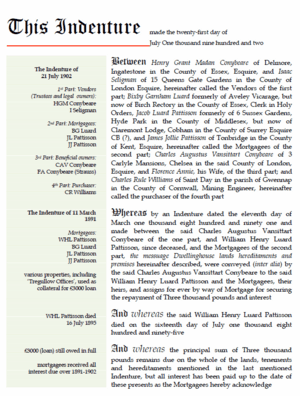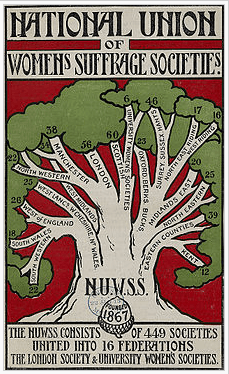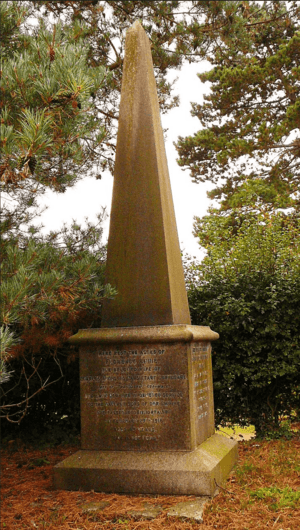Florence Annie Conybeare facts for kids
Florence Annie Conybeare (born September 13, 1872 – died February 29, 1916) was an important British campaigner for women's right to vote. She helped raise money for the cause and worked as a Voluntary Aid Detachment (VAD) nurse during the First World War. Florence was also a very active member of the Women's Liberal Federation.
Contents
About Florence
Her Family Background
Florence Conybeare was born Florence Annie Strauss on September 13, 1872, in Brixton, London. Her father, Gustave Strauss, was a successful merchant who sold Bohemian glass. He was from a town in the Czech Republic famous for glass and jewelry. Gustave moved to Britain and became a British citizen. Florence's mother was Frances Lehmaier. Florence was the oldest of three children. Her sister, Lily Julia Strauss, later married George May and became Lady Lily Julia May.
Growing Up in London
In 1881, when Florence was 8, she lived with her family in a house called Bleak House in Brixton, London. They had several servants who helped run the household. By 1891, at age 18, Florence and her parents had moved to Kensington, London. They still had many servants looking after their home.
Her Marriage
On October 15, 1896, Florence Annie Strauss, then 24, married Charles Augustus Vansittart Conybeare. He was 43, a lawyer, and had been a Liberal Member of Parliament (MP). Their wedding took place in a special church in Westminster, London. The service was led by Charles Voysey, a vicar with independent ideas. Florence's brother and sister also got married in the same church later on.
Marriage Settlement Explained
When Florence married, she became a part-owner of some properties, including the Tregullow Offices in Cornwall. This was part of a "marriage settlement." Think of it like a special agreement made before or during a marriage. It was a way for the husband to make sure his wife would have money and property, even if he left her. It helped protect the wife financially.
In 1896, the day before Florence's wedding, her husband Charles put these properties into a special arrangement called a "trust." This meant that two people, Isaac Seligman and Charles's brother Henry, became the legal owners of the properties. However, they only held the properties for Florence and Charles. This setup allowed Florence to receive money when parts of the properties were sold.
In 1902, Florence and her husband sold her share of the Tregullow Offices property for £170. A mining engineer bought it and renamed it Zimapan Villa.
Where They Lived
Florence and Charles Conybeare first lived in a fancy flat in Chelsea, London, right by the River Thames. Florence lived close to another women's rights activist, Sylvia Pankhurst. Later, they moved to Tregullow House in Cornwall. After that, they lived at Oakfield Park in Dartford, Kent.
Fighting for Women's Votes
Florence Conybeare was a very active supporter of the Women's Suffrage movement, which fought for women's right to vote. She helped organize events and spoke out for the cause.
The Women's Enfranchisement Bill (1907)
Florence supported a bill in 1907 called the "Women's Enfranchisement Bill." At that time, married women were not seen as "joint owners" of their homes. This bill wanted to change that. It proposed that husbands and wives living together should both be considered "joint occupiers" of their property. This would give married women equal standing with men and the right to vote.
Why Women Should Vote (1908)
In 1908, Florence wrote an important article called Some Objections Answered. In it, she argued that "Women's Suffrage is essentially a Liberal principle." She was replying to another writer, Edith Calkin, who was against women voting. Florence explained why women needed the right to vote and disagreed with Calkin's views.
Florence pointed out many unfair laws:
- She believed all women should be able to vote, no matter how much property they owned.
- It was wrong that women paid taxes but had no say in how that money was spent. She said "taxation and representation belonged together."
- She felt the Married Woman's Property Act of 1882 was unfair. For example, any savings a woman made while running her home belonged to her husband.
- Divorce laws were different for men and women, making it much harder for a wife to divorce her husband.
- Married women were not allowed to vote in local elections.
- She argued that women should be allowed to vote to help run the country. She noted that women had already played a big part in politics through groups like the Women's Liberal Associations.
Florence also spoke up for working women:
- She disagreed with the idea that a woman's place was only in the home.
- She defined "sweated labour" as women being paid less than men for doing the same job.
- Florence believed that women who had more free time had a duty to fight for the rights of working women.
- She urged working women to join together and demand the right to vote. She said it would "raise the status of working women," just as voting rights had improved the lives of the poorest male workers.
Suffragist Meeting in Dartford (1913)
On July 24, 1913, Florence Conybeare organized and led a meeting for the National Union of Women's Suffrage Societies in Dartford, Kent. An Australian suffragist named Miss Muriel Matters was invited to speak about "votes for women."
Florence started the meeting by standing on a wagon, which was used as a stage. She made it clear that they were not "militant suffragists" (meaning they didn't use violence). Instead, they wanted to achieve change through arguments and peaceful means.
Muriel Matters, who had been in prison for chaining herself to a grille in the House of Commons, arrived by car. She talked about how women in Australia already had the right to vote (since 1902). She pointed out that in Britain, women were treated like criminals or people with mental health issues because they couldn't vote, even though they paid taxes.
A journalist who reported on the event thought many people came just to see if there would be trouble. But the only incident was a stone thrown at the wagon, which caused no damage. At the end, Florence invited Councillor W.H.D. King to thank the speakers. He said he felt ashamed that he could vote while women could not.
Helping Her Community
Voluntary Aid Detachment
Florence Conybeare was very involved in the Voluntary Aid Detachment (VAD) at Charing Cross Hospital in London. VADs were volunteer nurses who helped during wartime. In January 1916, Florence was seen in her VAD uniform at a meeting in Dartford. People said that "Whatever she took up, Mrs Conybeare did thoroughly and with a will."
Fundraising for Soldiers
During the First World War, Florence Conybeare worked hard to raise money in Dartford. She asked people to donate to buy and equip an ambulance. This ambulance would be sent to the Western Front in France to help move wounded British soldiers from the battlefields to hospitals. She even wanted volunteers named "Florences" to drive the ambulance! She managed to raise the money, but her wish to have only "Florences" drive the ambulance didn't come true.
Women's Liberal Association
Florence was the President of the Dartford Women's Liberal Association. She was largely responsible for starting and running the "Babies Club," which likely helped mothers and young children in the community.
Her Last Days
Florence Conybeare passed away at her father's home in Kensington, London, on February 29, 1916. She was 43 years old. She had been unwell for about 18 months, but her death from pneumonia was sudden and unexpected. Her husband, Charles Conybeare, was away at the time. Florence was cremated, and a memorial service was held for her in London. She was buried in the cemetery of St Mary the Virgin Church in Fryerning, Essex, near her husband's parents. Charles Conybeare had a large stone monument built in her memory with a touching message:
Her Memorial Message
Here rest the ashes of Florence Annie The beloved wife of Charles Augustus Vansittart Conybeare Late of 'Tregullow', Cornwall Who gave her life in devoted service to the gallant sons of our Empire She passed into immortality on February 29th 1916 aged 43 She is not dead
After Her Death
On August 18, 1916, Florence Conybeare's will was officially approved, and her husband Charles was in charge of her estate. Florence was a wealthy woman when she died, leaving behind a significant amount of money.
Images for kids





